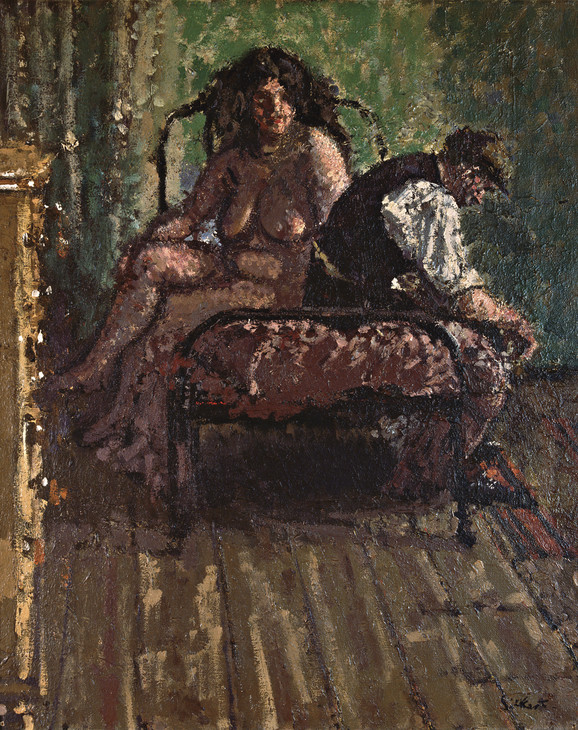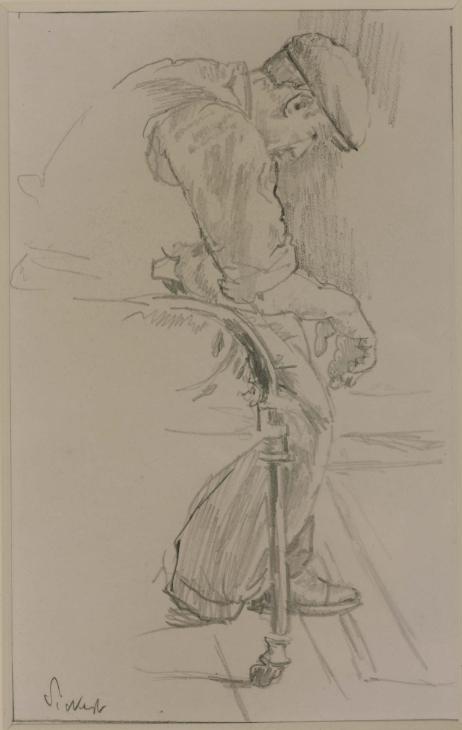Walter Richard Sickert Despair c.1908-9
Walter Richard Sickert,
Despair
c.1908-9
This drawing depicts a man in soft cap, waistcoat and rolled shirt-sleeves leaning heavily on the edge of a bed, head and shoulders downcast. His physical and perhaps mental exhaustion relates to the similar poses of lower class clothed men seated alongside naked women in Sickert’s psychologically affecting ‘Camden Town Murder’ painting series. The initial sketch was executed in swift pencil lines, with hatched strokes indicating areas of shadow and thicker, darker lines used to emphasise the overall composition.
Walter Richard Sickert 1860–1942
Despair
c.1908–9
Graphite on paper
270 x 200 mm
Inscribed by the artist in pencil ‘Sickert’ bottom left, ‘Fatigue’ bottom centre, ‘41’ top margin, ‘Ero’ right edge.
Presented by the Contemporary Art Society 1917
N03183
c.1908–9
Graphite on paper
270 x 200 mm
Inscribed by the artist in pencil ‘Sickert’ bottom left, ‘Fatigue’ bottom centre, ‘41’ top margin, ‘Ero’ right edge.
Presented by the Contemporary Art Society 1917
N03183
Ownership history
Purchased by Robert Ross at the Carfax Gallery, London, May 1912 (1), for the Contemporary Art Society; presented to Tate Gallery 1917.
Exhibition history
1912
Paintings and Drawings by Walter Sickert, Carfax Gallery, London, May 1912 (1).
1912
Loan Collection of Modern Paintings Organised by the Contemporary Art Society, Laing Art Gallery, Newcastle upon Tyne, October 1912 (60).
1913
The Contemporary Art Society: First Public Exhibition in London, Goupil Gallery, London, April 1913 (67).
1923
Contemporary Art Society Exhibition of Paintings and Drawings, Grosvenor House, London, June–July 1923 (38).
1960
Contemporary Art Society 50th Anniversary Exhibition, Tate Gallery, London, April–May 1960 (134).
1989–90
W.R. Sickert: Drawings and Paintings 1890–1942, Tate Gallery, Liverpool, March 1989–February 1990, Tate Gallery, London, July–September 1990 (6, reproduced).
References
1960
Lillian Browse, Sickert, London 1960, p.103.
1964
Mary Chamot, Dennis Farr and Martin Butlin, Tate Gallery Catalogues: The Modern British Paintings, Drawings and Sculpture, vol.2, London 1964, p.622.
1973
Wendy Baron, Sickert, London 1973, under no.273, p.349.
1996
Anna Gruetzner Robins, Walter Sickert: Drawings, Aldershot and Vermont 1996, pp.42, 91, reproduced pl.37.
2006
Wendy Baron, Sickert: Paintings and Drawings, New Haven and London 2006, no.357.1, pp.375–6.
Technique and condition
Sickert used a thin piece of off-white wove paper probably taken from a sketchbook for this study. The drawing is executed in two types of pencil. The outline of the figure was initially sketched in with a soft pencil line. Hatched strokes were then applied with the same pencil to indicate areas of shadow. The artist then used a softer darker pencil to add the highlights and to indicate the key structural points in the composition. The image is enclosed within a drawn rectangle that is angled at a slant to the edges of the paper and was probably applied by the artist during or after the drawing was executed. There are several inscriptions in the margins that seem to have been written by Sickert: ‘Fatigue’ is handwritten in pencil below the image as perhaps the original title of the work; the number ‘41’ is also inscribed in pencil in the top margin; and part of what appears to read ‘Ero’ is handwritten in pencil on the right edge, the rest of the inscription having been trimmed away at some point in the drawing’s history. There are traces of the outline of the image in a dark material on the back of the paper, which does not appear to be original drawing but may be the impression of the drawing made by placing a sheet of carbon paper behind it to transfer the image onto another piece of paper (see Tate N05095). Two pin-holes along the top edge indicate that the paper was either pinned to a board or had something pinned to it and might also be related to this technique.
Sarah Morgan
November 2006
How to cite
Sarah Morgan, 'Technique and Condition', November 2006, in Nicola Moorby, ‘Despair c.1908–9 by Walter Richard Sickert’, catalogue entry, June 2009, in Helena Bonett, Ysanne Holt, Jennifer Mundy (eds.), The Camden Town Group in Context, Tate Research Publication, May 2012, https://wwwEntry

Walter Richard Sickert 1860–1942
Dawn, Camden Town c.1909
Oil paint on canvas
510 x 400 mm
The Earl and Countess of Harewood
© Estate of Walter R. Sickert / DACS
Photo © By Kind Permission of the Earl and Countess of Harewood and the Trustees of the Harewood House Trust
Fig.1
Walter Richard Sickert
Dawn, Camden Town c.1909
The Earl and Countess of Harewood
© Estate of Walter R. Sickert / DACS
Photo © By Kind Permission of the Earl and Countess of Harewood and the Trustees of the Harewood House Trust
Following the example of his mentor Edgar Degas, the process of drawing represented a key but varied component in Sickert’s working practice. At times his sketches formed the structural basis for a finished painting and were created with the idea and composition already in mind, ready to be squared-up or otherwise transferred directly from paper to canvas, as in, for example, Study for ‘Ennui’ (Tate T00350). At other times, however, Sickert’s drawings were integral to the evolution of a motif as he constantly arranged and rearranged his models, sketching rapidly in pencil, pen and ink or charcoal in search of the most effective combination. The art historian Wendy Baron notes that the setting for the painting, Dawn, Camden Town, and therefore by association for the drawing, Despair, may be Sickert’s ‘Wellington House Academy’,10 a room on the corner of Granby Street and 247 Hampstead Road, which the artist once described as ‘my theatre’.11 Like many of his rented studios, he probably chose the place for its aesthetic qualities, relishing its authentically shabby features and the way that the light was filtered through grimy windows. For a time here he was also fascinated by the perspective of floorboards,12 as in, for example, Home Life, Camden Town (The Freeman Spogli Collection).13 It was in this studio that the artist created many of his most famous paintings dramatising the domestic interior, such as Ennui (Tate N03846). Sickert manipulated the space like a stage-set with props to create the perfect backdrop for his characters, providing instantly recognisable indicators regarding the social status of the room’s inhabitants.14 This careful dressing of the background was described by the writer Virginia Woolf as
the intimacy that seems to exist in Sickert’s pictures between his people and their rooms. The bed, the chest of drawers, the one picture and the vase on the mantelpiece are all expressive of their owner ... And of course Sickert composes his pictures down to the very castors on the chairs and the fire-irons in the grate.15
Although in Despair the details of the interior are sparse, they are nevertheless extremely evocative, the bare wooden floorboards and the utilitarian frame of the bed on castors mirroring the man’s blue-collar costume of rolled-up shirt-sleeves, waistcoat and cloth cap. The nature of the relationship between the drawing and the finished oil, Dawn, Camden Town, is not clear. Although it is likely that it was executed with the Camden Town Murder theme in mind, the existence of another study featuring the same man in a pose unrelated to the paintings suggests that it was part of a sequence of sketches dating from the same sitting. Wash and Brush-up (British Museum, London),16 a sketch in black and white chalk on magenta paper, depicts the man standing at table washing his hands in a shallow basin with his back turned to the viewer. The identity of the model is unknown but the slimness of his physique confirms that it is not Hubby, the artist’s usual choice of male sitter at this time.
Sickert was an accomplished draughtsman using a wide variety of techniques to suit his purpose. Despair employs swiftly drawn lines using both the point and the side of the pencil lead to create a range of tonal marks. The hard outline of the curve of the man’s back and the angularity of his face and arm contrast with the softness in the creases of his shirt and cap. The artist has created a third textural quality using vigorous hatching to denote the shadow within the palm of the sitter’s hand and the dark fabric of his trousers. There is also a neat frame drawn around the image, which Baron has suggested may be evidence of Sickert’s intention to publish.17 Sickert possibly considered sending Despair to the New Age, a weekly London periodical to which he regularly contributed drawings between 1910 and 1914. In addition to aesthetic and cultural issues the New Age had a socio-political agenda and featured commentary from major social critics from opposing sides of the political divide. Many of Sickert’s sketches which appeared there were concerned with snapshots of urban life and domestic labour, for example, Pail of Slops,18 which depicts a young female servant carrying a bucket. However, despite the apparent suitability of the subject matter and the linear quality of the drawing, Despair seems to have remained unpublished. It was first exhibited at the Carfax Gallery in 1912 at a solo exhibition containing fifty other drawings.19 As the art historian Anna Gruetzner Robins has pointed out, the majority of these sketches depicted intimate interior scenes, although Despair was unusual in its focus on a single male figure instead of a combination of men and women.20
Nicola Moorby
June 2009
Notes
See Robert Upstone, ‘Sensation: The Camden Town Murder’, in Modern Painters: The Camden Town Group, exhibition catalogue, Tate Britain, London 2008, pp.131–7.
The inscription has previously been erroneously recorded as ‘Fat Girl’; see Mary Chamot, Dennis Farr and Martin Butlin, Tate Gallery Catalogues: The Modern British Paintings, Drawings and Sculpture, vol.2, London 1964, p.622 and Wendy Baron, Sickert, London 1973, p.349. It was first correctly interpreted by Tate conservator, Sheila Fairbrass; see Tate Gallery Conservation Department Memorandum, June 1983, Tate Catalogue file.
Walter Sickert, letter to Nan Hudson, dated on the envelope 22 February 1914, Tate Archive TGA 9125/5, no.88; quoted in Wendy Baron, ‘The Domestic Theatre’, in Walter Sickert: ‘drawing is the thing’, exhibition catalogue, Whitworth Art Gallery, Manchester 2004, p.6.
For more on this, see William Rough, ‘Walter Sickert and Contemporary Drama’, The Camden Town Group, Tate 2011, http://www.tate.org.uk .
Baron 2006, no.358; reproduced in Anna Gruetzner Robins, Walter Sickert: Drawings, Aldershot and Vermont 1996, no.36, p.69.
Paintings and Drawings by Walter Sickert, Carfax Gallery, exhibition catalogue, London 1912 (1). There is an annotated copy of the catalogue in the Tate Archive, reproduced in Robins 1996, pp.91–3. Beside the title and catalogue number of this work an anonymous hand has written ‘Bt by the Contemporary Art Soc CAS’.
Related biographies
Related essays
- Walter Sickert and Contemporary Drama William Rough
Related reviews and articles
- Author unknown, ‘The Camden Town Group’ Yorkshire Observer, 1 December 1912.
- Charles Lewis Hind Daily Chronicle, 19 December 1912.
- G.R.H., ‘Gallery and Studio. The Camden Town Group’ Pall Mall Gazette, 12 December 1912, p.7.
- A.J. Finberg, ‘Art and Artists. The Camden Town Group and Others’ Star, 10 December 1912.
- Sir Claude Phillips, ‘The Camden Town Group’ The Daily Telegraph, 17 December 1912, p.14.
How to cite
Nicola Moorby, ‘Despair c.1908–9 by Walter Richard Sickert’, catalogue entry, June 2009, in Helena Bonett, Ysanne Holt, Jennifer Mundy (eds.), The Camden Town Group in Context, Tate Research Publication, May 2012, https://www


